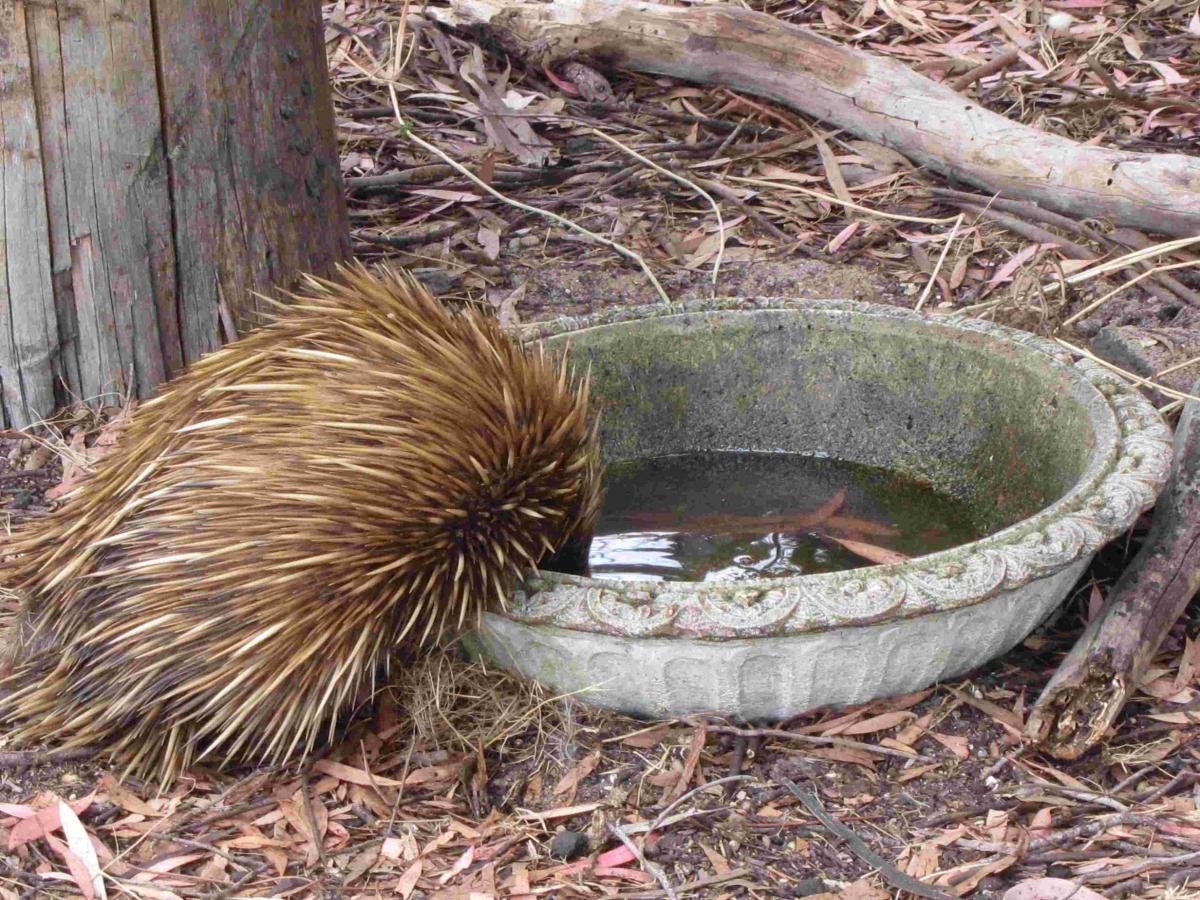Citizens recruited to unlock the secret lives of echidnas

Echidna takes a drink from a bird bath on Peter Hastwell's property. Photo credit: Peter Hastwell of Kangaroo Island.
Researchers at the University of Adelaide’s Environment Institute and members of the general public have recorded the largest number of echidna sightings across Australia to aid in the conservation of the iconic mammal.
In a paper published in PNAS, the researchers describe the outcomes of the Echidna Conservation Science Initiative (EchidnaCSI), a citizen science project established in collaboration with world-leading echidna ecologist Dr Peggy Rismiller OAM from Kangaroo Island’s Pelican Lagoon Research and Wildlife Centre.
In EchidnaCSI the general public are recruited to submit echidna sightings and scats to help researchers track echidna population changes, and to engage the public in scientific research and echidna conservation.
“My involvement in EchidnaCSI has been an enriching experience while feeling I am contributing to something worthwhile. I have gained an interest and knowledge about one of Australia’s more unusual animals while deepening the relationship I have with where I live.”EchidnaCSI participant Peter Hastwell from Kangaroo Island.
Participants download the free EchidnaCSI smartphone app through which they submit photos and information about echidna sightings. They also collect scats (faeces) for molecular analysis of echidna diet, gut health, reproductive health and potential stressors.
Since the project began in 2017, more than 11,000 members of the public have downloaded the EchidnaCSI app and submitted 12,000 echidna sightings from across Australia. This is the equivalent to 25 per cent of all echidna sightings listed in the Atlas of Living Australia, which covers more than the past 100 years data.
Professor Frank Grutzner from the University of Adelaide’s School of Biological Sciences said, “The short-beaked echidna is the most widespread native mammal in Australia, inhabiting diverse environments across Australia from bushland, to snow, to desert and tropical regions.
“This has made studying echidnas in the wild problematic. It is simply impossible for researchers to collect such a large number of sightings and scats.
“Through taking a citizen science approach we have been able to recruit thousands of members of the general public to collect data over large geographic and time scales.”
Dr Tahlia Perry from the University of Adelaide who oversees the running of the initiative, says data has been received from every state and territory, with many submitting sightings from densely populated areas, city fringes, and even within major cities.
“Although we expected most sightings to occur close to populated areas, we did not anticipate as many echidna sightings within or immediately surrounding all major cities in Australia,” said Dr Perry.
“This raises a number of concerns as there is very little appropriate habitat or food sources available for echidnas in these environments. It also increases the risk of echidnas being struck by vehicles.”
Unlike common ring-tailed possums or koalas, and in some cases even the platypus, echidnas have not previously been considered an ‘urban’ native species. The researchers suggest the findings of this study indicate there is a need to consider echidnas when establishing policies surrounding biodiversity in cities.
EchidnaCSI also successfully pioneered the method of incorporating wildlife scat collection into a nationwide citizen science project.
Through the EchidnaCSI app participants learned how to identify echidna scats from that of other animals. More than 400 echidna scats were collected for molecular analysis of diet and gastric health from locations as geographical unique as the Kimberley in WA, APY-lands in central Australia, remote areas of South Australia and far north and central Queensland. This makes the collection the largest for echidnas to date.
EchidnaCSI participant and Kangaroo Island resident, Peter Hastwell, has contributed the largest number of echidna sightings and scat samples to the project. Tired of seeing the wilderness being whittled away and wanting to play a part in protecting some of it, Peter has been an active participant in citizen science projects for more than 10 years.
“My involvement in EchidnaCSI has been an enriching experience while feeling I am contributing to something worthwhile. I have gained an interest and knowledge about one of Australia’s more unusual animals while deepening the relationship I have with where I live,” said Peter.
As a world-leading echidna ecologist Dr Peggy Rismiller says the data collected will go a long way in helping researchers map echidna populations.
“The subspecies of echidna that inhabits Kangaroo Island is the only extensively researched and monitored echidna population in Australia, which has resulted in the subspecies being listed as endangered,” said Dr Rismiller.
“It is therefore a matter of urgency to obtain more information to determine the conservation status of echidnas across Australia, particularly following the recent devastating Australian bushfires in 2019 and 2020.”
Media contacts
Professor Frank Grutzner, School of Biological Sciences, University of Adelaide, Mobile: +61 (0)417 026 302, Email: frank.grutzner@adelaide.edu.au
Dr Tahlia Perry, School of Biological Sciences, The University of Adelaide. Mobile: +61 (0)439 806 358, Email: tahlia.perry@adelaide.edu.au
Dr Peggy Rismiller, Kangaroo Island’s Pelican Lagoon Research and Wildlife Centre. Ph: +61 (08) 8553 7174, Email: rismac@internode.on.net
Kelly Brown, Acting Media Officer, External Relations, The University of Adelaide. Mobile: +61 (0)466 943 613, Email: k.brown@adelaide.edu.au
